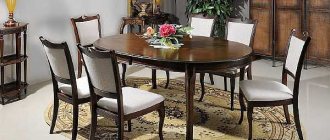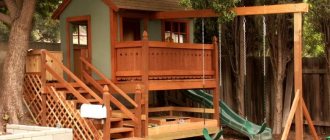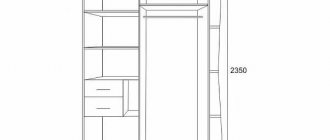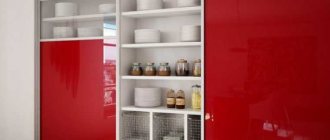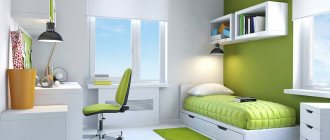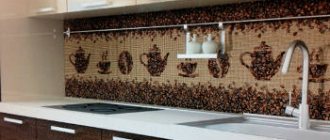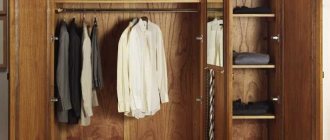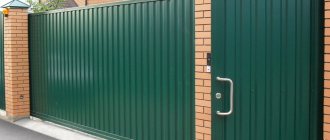Furniture manufacturers offer a large selection of built-in and cabinet models. Dimensions are selected according to individual requests or a sample is made according to the buyer’s drawings. But there are nuances that must be taken into account in order to correctly calculate the internal and external dimensions of the wardrobe. This will help to rationally use the area of the apartment and keep the selected model in working condition throughout its entire service life.
Cabinet sizes
There is no single regulatory documentation defining the correct dimensions of these interior items. GOST 13025.1-85 contains requirements for functional dimensions only partially. It works and is updated periodically. Otherwise, the right to imagination is left, so manufacturers rely on their own technical conditions. But, combining the requirements of GOST and the experience of manufacturers, the following dimensions can be identified.
Standard
Models with these dimensions are installed in a bedroom or living room with a template layout:
- base height - 10 cm;
- total depth - 50-60 cm, for shelves - 40-50 cm;
- height - 2.4-2.5 m, limited by the ceiling in the apartment;
- width - 2.2 m;
- pipe length for hangers - 80-100 cm;
- for blankets and other bedding, the length and width of the cell are 46*40 cm or 40*46, depending on the preferred method of arrangement;
- the minimum distance from the bottom of the shelf to the limiting object is 30 cm;
- depth of compartments for storing hats - 24 cm;
- shelf width - 40-100 cm.
The space for storing clothes on hangers is measured from the top edge of the bar to the floor and, according to the standard, should be no more than 190 cm. If the norm is exceeded, consider levers for lowering and raising the bar or other devices that make it easier to use the sector.
This is the width
The width of an object is necessary to understand the shape of both 2D and 3D objects. As a rule, it is denoted by the letter B.
Width is measured in meters (SI). But if the object is too small, then smaller units of measurement are used for convenience:
- decimeters,
- centimeters,
- millimeters
- micrometers, etc.
And if the object is too large , then the following prefixes are written:
- Kilo (10³),
- Mega (106),
- Giga- (109),
- Tera- (1012), etc.
Of course, such large units of measurement are necessary, for example, for astronomy. They are also used in quantum physics, microbiology, and so on.
What are the sides of a rectangle called?
Unlike a square, the sides of a rectangle are equal and parallel in pairs.
This means that the sides forming the angles are different.
Typically, the longer side of a rectangle is called the length, and the width of a rectangle is its short side.
Important! Knowing data such as the length and width of a rectangle, you can find its perimeter, area, length of the diagonals and the angle between them. You can always describe a circle around a rectangle. These properties also work in the opposite direction.
Non-standard models
Mini and maxi dimensions are classified as non-standard. There are many options for such cabinets. To produce them, specialists use 3D modeling. This allows you to create the most accurate option for a specific room.
Massive cabinets deeper than 500 mm and above 1500 mm require additional supports. The mezzanines of such compartments are made separately. Therefore, optimal designs should not exceed standard sizes. Typical cabinets are connected to each other to form a single line. In this regard, cabinet furniture with varying capacity stands out.
Variable Depth Models
These are designs of the following type: a compartment with shelves with a useful area of 60 cm, then a radius compartment with a transition to a body with a depth of 35 cm. Then a transition in the opposite direction is possible, if space allows. Fortuna, Maestro, Ikea, Aristo, Modus and other companies offer ready-made options, as well as accessories for making sliding wardrobes.
An example of a radius wardrobe diagram. View from above.
It is not necessary to be so strict in changing the depth. There are radius structures designed for installation in a corner:
- Convex - the useful area expands towards the center and decreases at the corners. We manufacture cabinets of various radii. Semicircular models have the most spacious center.
- Concave - small in volume products. They allow you to fit not a lot of outerwear, jackets, shirts on hangers, but its depth is the same over the entire area and is 35-50 cm.
- Combined is a combination of the two previous types of models, which are sometimes alternated with direct modules. Such cabinets are installed on the entire wall to accommodate the entire wardrobe. The structure itself will be from 35 to 90 cm deep in different areas.
The corner option is suitable where it is impossible to place other furniture. This saves space and has a positive effect on the aesthetics of the room.
Modular sections can be purchased in different depths
Dimensions of doors taking into account their number
The calculation of doors for a sliding wardrobe is carried out based on the total length and height of the furniture. For large structures, 2.2-2.5 m in height, choose doors such that the width of each of them is from 60 to 100 cm. Narrow and high doors tend to warp, and bulky ones put pressure on the rollers, rendering them inoperable. To prevent this from happening, it is important to stay within the given limits.
Shutters of smaller width are installed on a low panel. Its height cannot be less than 4 and more than 2 of its own width. With a door height of 1.6 m, it should be no wider than 0.8 m and no narrower than 0.4 m. This door fits the minimum dimensions of cabinets.
It is important to divide a cabinet of any length taking into account these rules in order to avoid distortions and doors falling out. For the same reason, mezzanines are separated. They are closed with swing doors, since the height of these auxiliary sections does not always allow the installation of sliding elements. On massive structures, 3, 4 or 5 pairs of sashes are installed. You can alternate them with swing elements.
Take into account that the usable area behind the doors is reduced by 10 cm. The thickness of each door is 35-40 mm. Two of them always intersect, so the number is multiplied by 2. To 70-80 mm another 20-30 is added to avoid the valves touching each other. When the doors overlap, the area is halved.
The influence of the number of valves on calculations
Dimensions of narrow washing machines
Narrow devices with a depth of 40 to 50 cm are called. The maximum load of laundry is up to 5 kg.
They have no fewer operating modes than deeper models: for example, Gorenje WS 62SY2B with a depth of 44 cm has 16 washing programs and the function of storing the most used programs in memory. Model Gorenje MV62FZ12/S with the same depth of 44 cm - 18 programs and automatic determination of water temperature and wash duration.
Among the narrow ones, one can distinguish a group of small-sized machines with a loading weight of up to 3.5 kg - for example, Electrolux EWC1350, whose depth is 51 cm, width - 49.5 cm, and height 67 cm. The low loading weight here is due to the low height of the machine, which allows install it under the sink.
Guide dimensions
The length of the roller track is usually 2.5-3 meters , and the maximum is 5.4 m. If necessary, it can be shortened. The width of the upper guide, as well as the lower one, is 82 mm. If there are additional accessories, then each of them accounts for up to 1 cm. This figure easily fits into the space for installing doors, left in reserve - 10 cm.
The components include:
- supports or hangers;
- profile caps;
- clamps;
- seal.
On profileless systems, guides with a width of 82.4 cm are installed. The length of the profile attached to the chipboard is 2, 3 or 6 mm.
The choice of fittings is influenced by the height of the sash. The higher the door, the stronger the foundation it needs. A three-door cabinet will require double or triple guides, that is, several profiles. Structures with two doors can be placed on the same rails, provided that the height of the doors does not exceed 1.5 m.
Dimensions length, width, height
The production of asbestos-cement profiles is organized in accordance with state standards: 3034095 for wave and 1812495 for flat.
Wave ACLs
Although the composition of the building material is the same, the size of the product may vary. This also applies to the thickness of the product. As a rule, it varies in the range from 5 to 9 mm. As for the width, it is determined by the number of waves.
The ACL profile depends on the cross-sectional shape and the distance between the waves. The cross-sectional shape is of two types - 40 by 150 and 54 by 200. The first number of this indicator (40 or 54) indicates the height of the wave, and the second (150 or 200), respectively, its pitch. The height of the slate is nothing more than the length of the segment connecting the top of the wave and the bottom, without taking into account the thickness of the profile.
| Slate option | Height | Width | Length | Wave step | |
| 7 waves. | 8 waves. | 6 waves. | |||
| 40/150/1750 | 40 | 980 | 1130 | 1750 | 150 |
| 54/200/1750 | 54 | 1125 | 1750 | 200 |
Note: Domestic manufacturers have the right to produce non-standard ACLs based on their own specifications.
Sheets with different profiles are classified into three groups:
- VO – regular profile;
- UV – unified;
- VU – reinforced.
- for ordinary ones - 1.2 by 0.68 m;
- for unified – 1.75 by 1.125 m;
- for reinforced ones, the slate length is 2.80 m.
- waves of modern asbestos cement sheets - six, seven and eight. For example, a standard 8-wave slate is 1.75x1.13 m with a thickness of 5.2 or 5.8 mm, area size is 1.977 sq. m. 7 and 8 have the same height, but the width is different, since the number of waves does not match.
Flat ACLs
Certain qualities of flat and wave profiles are similar, however, there are certain differences between them. For example, flat ones may not be pressed, which means that they will differ in their technical characteristics. It should be noted that flat ACLs are more durable compared to wave ones. For example, their compressive and bending strength reaches 90-130 and 20-50 MPa, respectively.
The main advantage of this material, most likely, is the variety of its uses. Just a few examples:
- the sufficiently low weight allows the use of flat profiles when constructing floors, and additional reinforcement elements are not used.
- quite often used as interior and exterior decoration of buildings;
- with their help, partitions of various types and vertical fences are erected.
- length can be 2.5, 3.0 and 3.5 m;
- width – 1.2 and 1.5 m;
- thickness – 0.6, 0.8 and 1.0 cm.
On the construction market you can also find industrially produced flat sheets of smaller dimensions (length - 0.6 m, width - 0.4 m), which are suitable for roofing.
It should be noted that manufacturers produce custom profiles of other dimensions and shades. The developed dyes are resistant not only to atmospheric influences, but also to fading.
2019stylekrov.ru
Cabinet filling elements
The insides of the coupe are:
- Open side shelves - useful area of each from 35 cm.
- Pull-out baskets are located at a height of 1.2 m. Their capacity and quantity depend on the specific model. The boxes can be placed in different compartments.
- Compartment for shoes - allocated at the bottom of the structure. You can use mesh baskets to store boots. The width of their walls is 1 cm, which has a slight effect on the calculations.
- Sector for outerwear. The rack is placed at a height of 1.5-1.7 m. The optimal usable depth of the cabinet should be 70 cm or more. This will prevent the sashes from touching the jackets.
- Department for storing suits, shirts, trousers on hangers. The minimum height of the rack from the floor is 110 cm, the depth of the section is 60 cm. When manufacturing a module with two rods, a distance of 90 cm is provided between them.
- Closed shelves.
- Mezzanine.
The presence of open modules is useful in the nursery and living room for storing books and toys. Additional upper sections will help hide out-of-season clothes and shoes.
Criteria for choosing a cabinet by size
Before purchasing a cabinet, it is important to think through the contents in detail. The dimensions depend on this. You need to pay attention to the following details:
- The correspondence between the height of the door and its width is no less than 1:4 and no more than 1:2.
- For massive models, each partition must have a door leaf.
- The maximum size of a mirror on a door is 3.21 by 2.25 m. It must have a protective film 4 mm thick. These requirements also apply to coupes with glass doors.
- Correspondence between the dimensions of the mechanism and the profile.
The built-in and cabinet cabinets are checked for compliance with these points. It is important to check the model's configuration. It varies among manufacturers. It is necessary to have tracks for the sliding system, fasteners, a hexagon, and assembly instructions.
It is important to consider the height of each rod for the clothes of all family members
Cabinet size - what is the right size?
Briefly: - the depth of the hinged wardrobe (with hinged fronts) is optimal - 60 cm - the depth of the sliding wardrobe (with sliding fronts) is optimal - 65 cm , it is better if 70 cm, because sliding doors “eat” up to 10cm in depth
When coordinating built-in and cabinet furniture, we often encounter various misconceptions about the optimal or maximum possible sizes when using a particular material. In this article we will share our experience, based both on theoretical knowledge (special technical education, with the study of GOSTs and design standards), and practical knowledge, taking into account more than one thousand completed projects over 11 years of work in the furniture industry.
Maximum cabinet height with solid side panel made of laminated chipboard without joints
If you really want to make a built-in or cabinet cabinet up to the ceiling, you should take into account the size of the sheet of material from which its parts will be cut, and most importantly, the side walls and internal partitions. It must be borne in mind that the sheet size of the most popular material - laminated chipboard (chipboard) H * W = 2800 * 2070 mm. Thus, in order for the side walls of the cabinet to be solid , without joints or splices, their size should be max 2780mm . A couple of centimeters were taken away from the so-called trimming (trimming the edges of chipboard on a cutting machine).
Fortunately, material manufacturers are aware that the ceiling height in most residential premises has dimensions of 2530...2640...2700mm, etc., so you rarely encounter the problem of a lack of length of parts. But if the question still arises, then when designing and manufacturing it is necessary to resort either to custom-made non-standard materials, or, in order not to increase the cost of the product, to correctly join and splice parts.
Maximum width (length) of the cabinet with a solid roof/bottom made of laminated chipboard without joints
When designing wide (long) cabinets with more than 2 sliding doors, you should also take into account the size of the sheet of material from which its parts will be cut. In order for the shelves, bottom and roof of the cabinet to be solid , without joints or splices, their size must be max 2780mm. Taking this into account, the maximum length of the cabinet will be about 2816-2850mm (added the thickness of the side walls, which usually have a size of 18-36mm).
With large cabinet sizes, you have to resort to various design tricks.
The depth of the cabinet is optimal for storing clothes on hangers
In our company, the optimal standard depth of a sliding wardrobe is considered to be 650mm , and if the room is possible, the recommended depth will be 700mm . These dimensions are based on the sum of “shoulder depth” + “sliding system thickness”. Many people mistakenly forget that their old wardrobe, 60cm deep, has thin hinged doors, and by transferring this size to a modern wardrobe with a “sliding system thickness” of 6-9cm, we end up with a lack of precious useful depth. As a result, clothes on hangers are difficult to fit inside the closet. 600mm is the required minimum for a wardrobe with sliding doors.
As for the optimal standard depth of a cabinet with hinged doors, the standard of 600mm is definitely suitable here.
If there is a lack of internal space in depth, the most popular solution, although not very convenient, would be to place “perpendicular” hangers. Those. We hang clothes facing the door.
Blueprints
The project is compiled based on the width, height and design of the room. Take into account the presence of elements that can adjust the installation area:
- wall unevenness;
- skirting boards and baguettes;
- interior items;
- sockets, switches on the wall.
The height of the room is measured at three points, deviations within 15 mm are allowed. The minimum measurement value is taken as the height of the opening. The width is measured relative to the ceiling and floor near the wall and at the distance from it where the cabinet doors will be located. For this parameter, the difference can reach 20 mm, and the final value is equal to the maximum value. If these figures are exceeded, adjustment will be impossible and the walls will need to be leveled.
All necessary filling elements are applied to the drawings. Leave a distance of 5 mm from the walls to the door and between the doors. If there is a suspended ceiling, leave a gap of 4 cm between it and the mezzanine. All calculations can be made online. Some computer drawing programs are available free of charge.
Options for cabinet sizes depending on the number of doors and contents
To prevent the installation of a sliding wardrobe from turning into torture, it is necessary to correctly indicate all the parameters of the room. The dimensions of the rack are determined by the spaciousness of the apartment, the strength of the materials and the imagination of the customer. This makes it easier to plan compartments for clothes and belongings. Compartments with concave and convex planes allow rational use of useful space.
